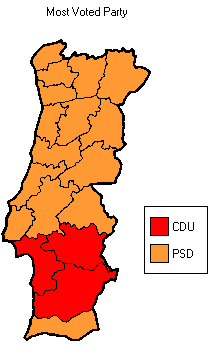1987 European Parliament election in Portugal
| |||||||||||||||||||||||||||||||||||||||||||||||||||||||||||||
24 seats to the European Parliament | |||||||||||||||||||||||||||||||||||||||||||||||||||||||||||||
|---|---|---|---|---|---|---|---|---|---|---|---|---|---|---|---|---|---|---|---|---|---|---|---|---|---|---|---|---|---|---|---|---|---|---|---|---|---|---|---|---|---|---|---|---|---|---|---|---|---|---|---|---|---|---|---|---|---|---|---|---|---|
| Turnout | 72.4% | ||||||||||||||||||||||||||||||||||||||||||||||||||||||||||||
| |||||||||||||||||||||||||||||||||||||||||||||||||||||||||||||
The European Parliament election of 1987 in Portugal took place on 19 July 1987.[1] It was the election of all 24[1] MEPs representing the Portugal constituency for the remainder of the 1984–1989 term of the European Parliament. Portugal had acceded to the European Community on 1 January 1986 and had been represented in the European Parliament by 24 appointed delegates until elections could be held. These elections took place on the same day of the legislative elections of 1987.
The Social Democrats (PSD) won the 1st European election by a landslide over the Socialists. The PSD won more than 37% of the votes, 15 points ahead of the PS. Note that a large chunk of the PSD vote in the 1987 legislative elections, held simultaneously with the European election, was from CDS voters that voted PSD in the general election and CDS in the EU elections. Nonetheless, the CDS won 15% of the votes, compared with the 4% in the general election ballot. Together, the center-right parties won 53% of the votes.
The Socialists, headed by former PM Maria de Lourdes Pintasilgo, suffered a huge defeat, polling just 22%, matching their general election score. The Communist/Green alliance, Democratic Unity Coalition, polled 4th place and won 11.5% of the votes. Finally, the Democratic Renewal Party (PRD), also suffered a very heavy defeat, winning just 4% of the votes and electing a sole member for the EU Parliament.
Turnout in these elections was quite high, with 72.4% of voters casting a ballot.
Electoral System
The voting method used, for the election of European members of parliament, is by proportional representation using the d'Hondt method, which is known to benefit leading parties. In the 1987 EU election, Portugal had 24 seats to be filled. Deputies are elected in a single constituency, corresponding to the entire national territory.
Parties and candidates
The major parties that partook in the election, and their EP list leaders, were:[2]
- Democratic Unity Coalition (CDU), Ângelo Veloso
- Socialist Party (PS), Maria de Lourdes Pintasilgo
- Democratic Renewal Party (PRD), José Medeiros Ferreira
- Social Democratic Party (PSD), Pedro Santana Lopes
- Democratic and Social Centre (CDS), Francisco Lucas Pires
National summary of votes and seats
Template:European Parliament election, 1987 (Portugal)
Distribution by European group
| Groups | Parties | Seats | Total | % | |
|---|---|---|---|---|---|
| bgcolor="Template:European Liberal Democrat and Reform Party/meta/color"| | Liberal Democrat and Reform Party (LDR) |
|
10 | 10 | 41.67 |
| width="1" bgcolor="Template:Socialist Group/meta/color"| | Socialist Group (SOC) |
|
6 | 6 | 25.00 |
| bgcolor="Template:European People's Party/meta/color"| | European People's Party (EPP) | 4 | 4 | 16.67 | |
| bgcolor="Template:Communists and Allies/meta/color"| | Communists and Allies (COM) | 3 | 3 | 12.50 | |
| bgcolor="Template:European Democratic Alliance/meta/color"| | European Democratic Alliance (EDA) |
|
1 | 1 | 4.17 |
| Total | 24 | 24 | 100.00 | ||
Maps
-
Most voted political force by municipality.
References
- ^ a b "Results of the 19 July 1987 election of the 24 delegates from Portugal to the European Parliament" (in Portuguese). Portuguese Electoral Commission. Retrieved 30 November 2008.
- ^ Comissão Nacional de Eleições - Deputados[permanent dead link]
- ^ "Elecciones al Parlamento Europeo: Resultados por países 1979 - 2014". historiaelectoral.com (in Spanish). Retrieved 28 November 2017.





